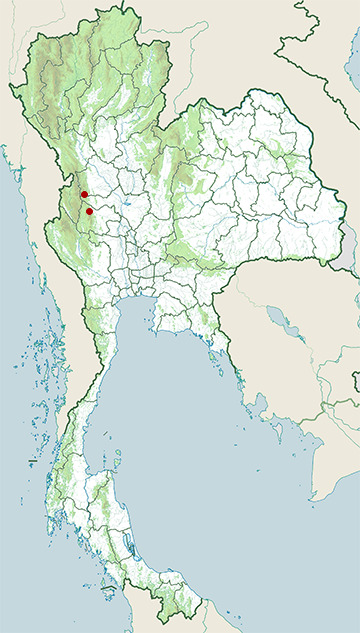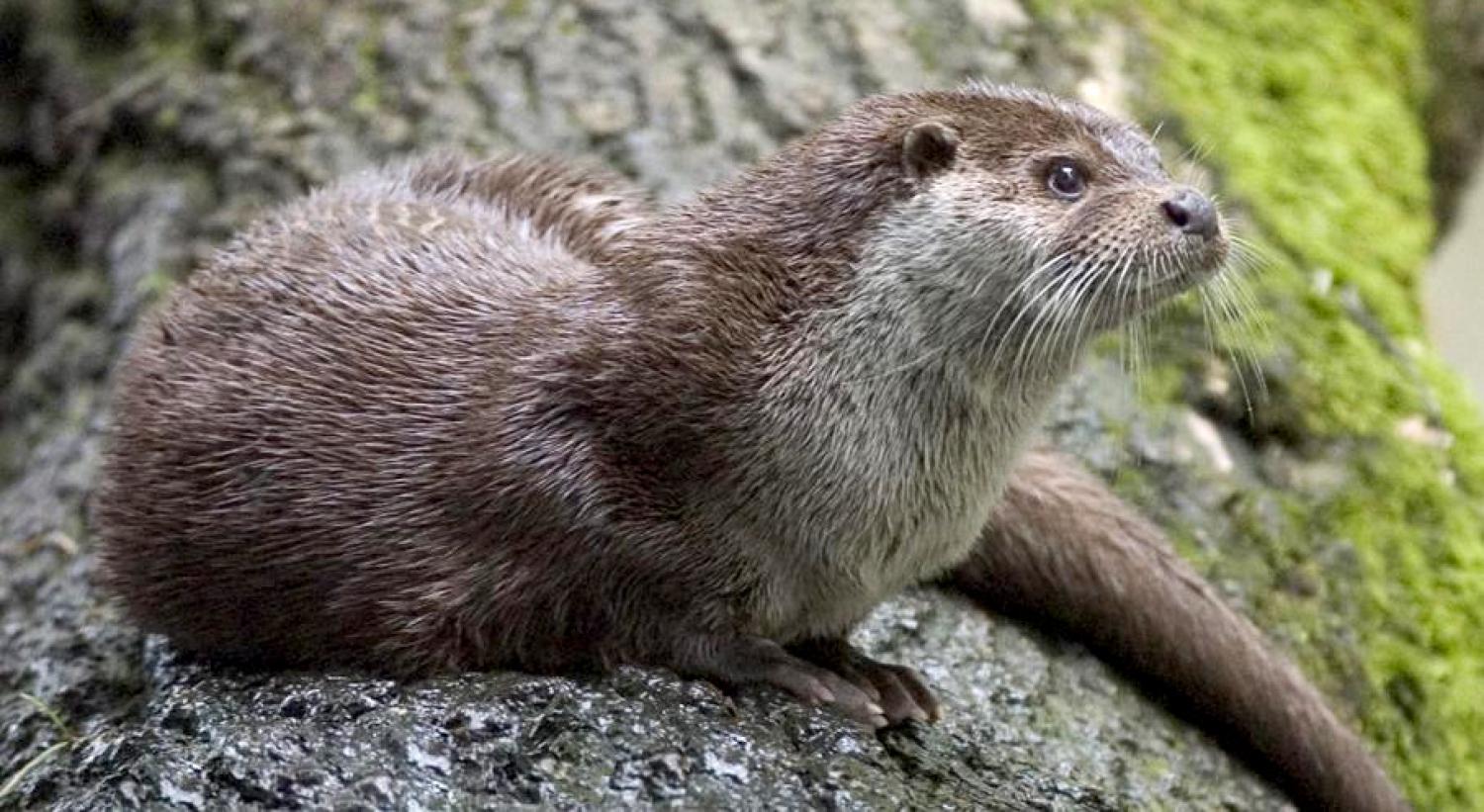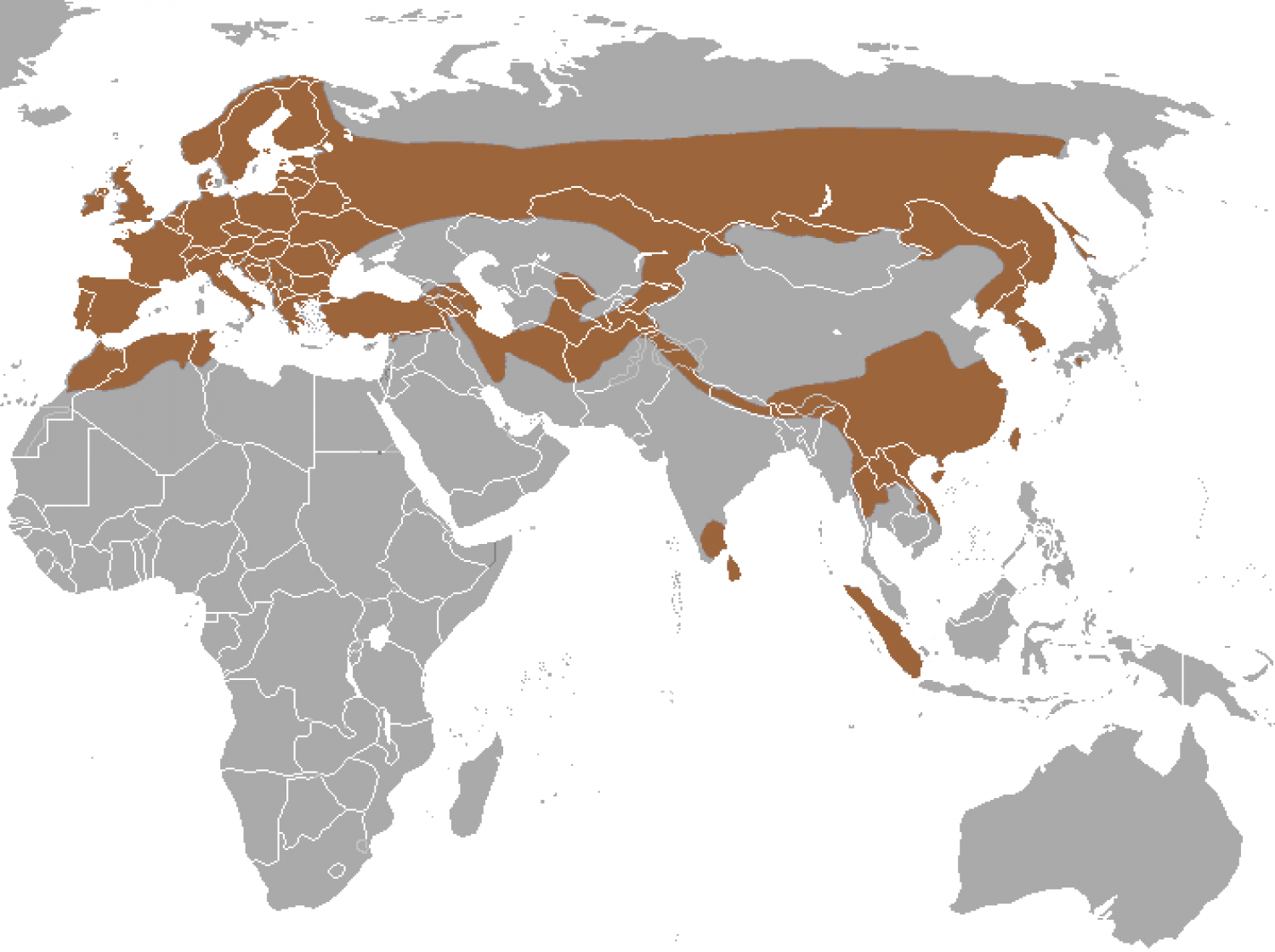Species of Thailand
European otter
Lutra lutra
(Carolus Linnaeus, 1758)
In Thai: นากใหญ่ธรรมดา
The Eurasian otter (Lutra lutra), also known as the European otter, Eurasian river otter, common otter, and Old World otter, is a semiaquatic mammal native to Eurasia. The most widely distributed member of the otter subfamily (Lutrinae) of the weasel family (Mustelidae), it is found in the waterways and coasts of Europe, many parts of Asia, and parts of northern Africa. The Eurasian otter has a diet mainly of fish, and is strongly territorial. It is endangered in some parts of its range, but is recovering in others.
Description
The Eurasian otter is a typical species of the otter subfamily. Brown above and cream below, these long, slender creatures are well-equipped for their aquatic habits. Their bones show osteosclerosis, increasing their density to reduce buoyancy. This otter differs from the North American river otter by its shorter neck, broader visage, the greater space between the ears and its longer tail. However, the Eurasian otter is the only otter in much of its range, so it is rarely confused for any other animal. Normally, this species is 57 to 95 cm round=0.5 long, not counting a tail of 35 – 45 cm round=0.5. The female is shorter than the male. The otter's average body weight is 7 to 12 kg, although occasionally a large old male may reach up to 17 kg. The record-sized specimen, reported by a reliable source but not verified, weighed over 24 kg.
Distribution and habitat
The Eurasian otter is the most widely distributed otter species, its range including parts of Asia and Africa, as well as being spread across Europe, south to Palestine. Though currently believed to be extinct in Liechtenstein and Switzerland, they are now very common in Latvia, along the coast of Norway, in the western regions of Spain and Portugal and across Great Britain, especially Shetland, where 12% of the UK breeding population exists. Ireland's otters are geographically widespread and believed to be the most stable population in Europe. In Italy, they can be found in southern parts of the peninsula. The South Korean population is endangered. In India, the species is distributed in the Himalayan foothills, southern Western Ghats and the central Indian landscape.
In general, their varied and adaptable diets mean they may inhabit any unpolluted body of fresh water, including lakes, streams, rivers, canals and ponds, as long as the food supply is adequate. In Andalusia, the golf courses became part of their habitat. Eurasian otters may also live along the coast, in salt water, but require regular access to fresh water to clean their fur. When living in the sea, individuals of this species are sometimes referred to as "sea otters", but they should not be confused with the true sea otter, a North Pacific species much more strongly adapted to a marine existence.
The extinct Japanese river otter is usually considered a subspecies.
Diet
The Eurasian otter's diet mainly consists of fish. Fish is their most preferred choice of food in Mediterranean and temperate freshwater habitats. During the winter and in colder environments, though, fish consumption is significantly lower, and the otters use other sources of food, including amphibians, crustaceans, insects, birds and sometimes small mammals, including young beavers.
Breeding
Eurasian otters are strongly territorial, living alone for the most part. An individual's territory may vary between about 1 and(-) 40 km long, with about 18 km being usual. The length of the territory depends on the density of food available and the width of the water suitable for hunting (it is shorter on coasts, where the available width is much wider, and longer on narrower rivers).The Eurasian otter uses its feces, spraints, to mark its territory and prioritize the use of resources to other group members. The territories are only held against members of the same sex, so those of males and females may overlap. Mating takes place in water. Eurasian otters are nonseasonal breeders (males and females will breed at any time of the year) and it has been found that their mating season is most likely determined simply by the otters' reproductive maturity and physiological state. Female otters become sexually mature between 18 and 24 months old and the average age of first breeding is found to be years. Gestation for the Eurasian otter is 60–64 days, the litter weighing about 10% of the female body mass. After the gestation period, one to four pups are born, which remain dependent on the mother for about 13 months. The male plays no direct role in parental care, although the territory of a female with her pups is usually entirely within that of the male. Hunting mainly takes place at night, while the day is usually spent in the Eurasian otter's holt (den) – usually a burrow or hollow tree on the riverbank which can sometimes only be entered from underwater. Though long thought to hunt using sight and touch only, evidence is emerging that they may also be able to smell underwater – possibly in a similar manner to the star-nosed mole.
Conservation
The Eurasian otter declined across its range in the second half of the 20th century primarily due to pollution from pesticides such as organochlorine and polychlorinated biphenyls. Other threats included habitat loss and hunting, both legal and illegal. Eurasian otter populations are now recovering in many parts of Europe. In the United Kingdom, the number of sites with an otter presence increased by 55% between 1994 and 2002. In August, 2011, the Environment Agency announced that otters had returned to every county in England since vanishing from every county except the West Country and parts of Northern England. Recovery is partly due to a ban on the most harmful pesticides that has been in place across Europe since 1979, partly to improvements in water quality leading to increases in prey populations, and partly to direct legal protection under the European Union Habitats Directive and national legislation in several European countries. In Hong Kong, it is a protected species under Wild Animals Protection Ordinance Cap 170. It is listed as Near Threatened by the IUCN Red List.
In Asia, it is listed as endangered in Pakistan, India, Bangladesh, Myanmar and Thailand, and critically endangered in Mongolia.
Most species that are victims of population decline or a loss of habitat tend to eventually lose their genetic difference due to inbreeding from small populations. A study conducted in 2001, examined whether or not the populations of Eurasian otters suffered from a lack of genetic variability. In the study, they examined teeth of otter skulls at the Zoological Museum, Copenhagen and the Natural History Museum, Aarhus. The samples were collected between 1883 and 1963 in Denmark (Funen, Zealand, and Jutland). The study examined the tissue on the teeth of the skulls and determined the genetic variability based on DNA analysis. In conclusion, the study discovered that despite the population declines, the Eurasian otter was not a victim of declining genetic variability.
The decline in population of native freshwater fishes, which is the preferred food of Eurasian otters, in the rivers of Iberia, along with the expansion of exotic fish species like centrarchids could potentially put Eurasian otters at risk for extinction.
This article uses material from Wikipedia released under the Creative Commons Attribution-Share-Alike Licence 3.0. Eventual photos shown in this page may or may not be from Wikipedia, please see the license details for photos in photo by-lines.
Scientific classification
- Kingdom
- Animalia
- Phylum
- Chordata
- Class
- Mammalia
- Order
- Carnivora
- Family
- Mustelidae
- Genus
- Lutra
- Species
- Lutra lutra
Common names
- German: Fischotter
- English:
- Common otter
- Eurasian otter
- European otter
- European river otter
- Old world otter
- Spanish:
- Nutria
- Nutria Común
- French:
- Loutre commune
- Loutre de rivière
- Loutre d'Europe
- Italian: Lontra europea
- Dutch:
- Otter
- Europese otter
- Visotter
- Russian:
- Вы́дра
- речная выдра
- обыкновенная выдра
- поре́шня
- Swedish:
- Utter
- Eurasisk utter
- Thai: นากใหญ่ธรรมดา
Synonyms
- Lutra nippon, Yoshinori Imaizumi & Mizuko Yoshiyuki (1989)
- Viverra lutra, Carolus Linnaeus (1758)
Conservation status

Near Threatened (IUCN3.1)
Photos
Please help us review our species pages if wrong photos are used or any other details in the page is wrong. We can be reached via our contact us page.
Range Map

- Huai Kha Khaeng Wildlife Sanctuary
- Mae Wong National Park

